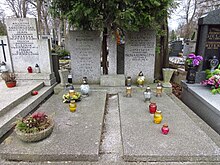Jerzy Jankowski: Difference between revisions
Task 4: Remove Template:Draft categories from mainspace article |
|||
| Line 39: | Line 39: | ||
<references /> |
<references /> |
||
{{Draft categories| |
|||
[[Category:Polish designers]] |
[[Category:Polish designers]] |
||
[[Category:1920 births]] |
[[Category:1920 births]] |
||
[[Category:1986 deaths]] |
[[Category:1986 deaths]] |
||
}} |
|||
Latest revision as of 05:08, 16 November 2024
This article has an unclear citation style. (October 2024) |
Jerzy Jankowski | |
|---|---|
| Born | 4 July 1920 |
| Died | 27 November 1986 (aged 66) |
| Occupations |
|
Jerzy Jankowski was a Polish motorcycle and racing driver/designer.
Early life
[edit]He was born in 1920 in Będzin. In 1936 he started racing racing motorcycles in the colors of the Pogoń Dąbrowa Górnicza club.[1] Then he raced in the colors of Polonia Bytom and Legia Warsaw.[2] In 1939 he modified the DKW RT3 motorcycle, which was described by the magazine Motorcycle and Cyclecar.[1]

Career
[edit]Motocycling
[edit]In 1947 he won the gold medal in the Six-Day Race.[1][2] In the same year he organized a sports team of the SHL plant.[1] In 1948, together with the team, he won the International Motorcycle Marathon, organized in Poland and Czechoslovakia.[2] After working for SHL, he found employment at WFM. There he co-created sports motorcycles and the WFM Osa scooter.[1]
In 1953, he ended his career as a motorcycle racer due to a serious leg injury sustained on the Sześciodniówka. During his stay in hospital, Jankowski developed a prototype of the Moto-Rak motorcycle, which did not go into production.
Driving career and engineering
[edit]In October 1957, he became the head of the Centre for the Construction of Performance Cars.[3] During this period, Jankowski developed the first Polish racing car built from scratch, designated Rak 650. This vehicle, based on a lightweight space frame, was powered by a Triumph engine.[4] In 1958, Jankowski won the Polish Championship title with this vehicle.[5]
In 1959 he won the Budapest Grand Prix.[2] During this period he began developing a car compliant with Formula Junior regulations – Rak Junior I.[6] In 1963 he co-initiated the Cup of Peace and Friendship, which was held until 1990, in which drivers from socialist countries competed[7][8]
After the international regulations changed from Formula Junior to Formula 3 after 1963, Jankowski began developing a car to that specification.[9] The result was the Rak 64, with which Jankowski won the Polish championship title in 1964 and the inaugural Cup of Peace and Friendship.[10] In 1966, he won the race at the Strahov Stadium.[11] After 1966, Jankowski ended his racing career. The last racing car he designed was the Promot-Rak 67.[12]

In total, Jankowski was the author of 23 racing motorcycle and car designs and 19 patents. In the years 1950–1953 he was the Polish champion and vice-champion ten times in motorcycle racing, and was also a three-time Polish champion in auto racing.[1][2]
Death
[edit]He died on 27 November 1986. He was buried at the Bródnowski Cemetery in Warsaw, Poland.[13]
References
[edit]- ^ a b c d e f "Elita motocyklistow polskich Jerzy Jankowski". swiatmotocykli.pl. Retrieved 2024-10-29.
- ^ a b c d e Chyła: Polskie wyścigi samochodowe. s. 212.
- ^ Steć: Polskie samochody wyścigowe. p. 64.
- ^ Steć: Polskie samochody wyścigowe. pp. 65-66
- ^ Steć: Polskie samochody wyścigowe. p. 71.
- ^ Steć: Polskie samochody wyścigowe. p. 94.
- ^ web.archive.org/web/20180811204403/http:/www.teamdan.com:80/archive/www2/soviet/fscc.html
- ^ https://web.archive.org/web/20161020095709/http://www.automobilklubpolski.pl/historia/monografia/sportsam_fr.pdf
- ^ Steć: Polskie samochody wyścigowe. p. 114.
- ^ Steć: Polskie samochody wyścigowe. pp. 117-118.
- ^ "F2 Register - Index".
- ^ Steć: Polskie samochody wyścigowe. p. 129, 168.
- ^ Chyła: Polskie wyścigi samochodowe. p. 213.
